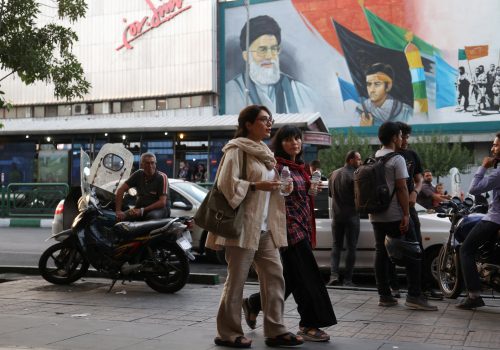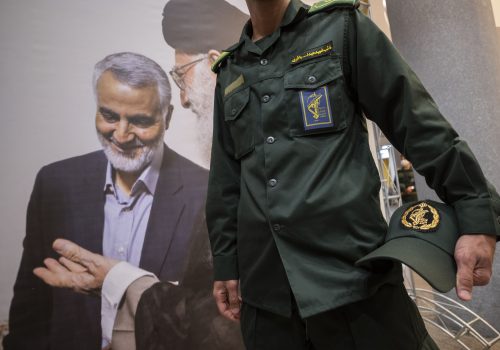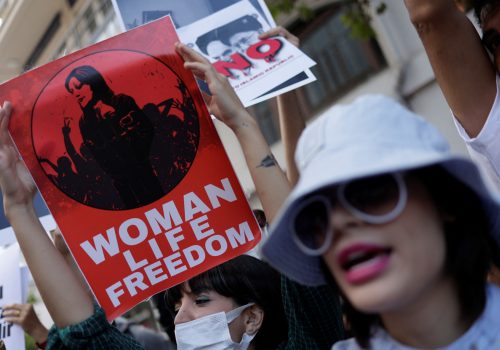Iran will never go back to the way it was
Their hair blowing freely in the wind, a couple dozen Iranian girls in oversized t-shirts and baggy pants rollerbladed next to their male counterparts in the streets of the southern city of Shiraz. This is the new Iran, where every day, Iranians participate in various brave acts of civil disobedience that risk arrest and imprisonment.
While some argue that the ongoing anti-establishment protests began in mid-September 2022 after the death of Mahsa Jina Amini in police custody—Iran’s Mohamed Bouazizi moment—the reality is that Iranians have been defying the regime en masse for years. This durable resistance signals why Iran cannot go back to the way it was.
Over its four-decade history, there have been many cracks in the nezam (system)—the 1999 student uprising and 2009 post-election protests known as the Green Movement, for instance—but one of the most considerable fissures arguably began in December 2017. Ironically, the protests of that winter were ignited by hardliners in the northeastern city of Mashhad, who turned out in numbers to protest then-President Hassan Rouhani’s economic policies on December 28, 2017. This event coincided—just a day before—with the beginning of the “Girls of Revolution Street” movement, where women took off their mandatory hijab on Enghelab (Revolution) Street in the capital, Tehran.
Before long, the fire started by hardliners became one that could no longer be put out. The chant, “reformists, hardliners, the game is over,” became the battle cry of the December 2017-January 2018 protests—at the time, known as the largest in terms of geography since the 1979 revolution—and part of protests thereafter.
That moment penetrated the clerical establishment’s veneer of reform and permanently exposed it for what it was: an irredeemable regime that is systemically corrupt, mismanaged, and repressive.
While protests have become normalized since December 2017-January 2018—with students, teachers, truckers, and workers leading the way in strikes and demonstrations thereafter—one specific protest, the Aban Khoonin (Bloody Aban), or November 2019 protests, which was prompted by a fuel hike, ossified the views of the people of Iran.
Deliberately using an Internet shutdown as cover, security forces brutally killed 1,500 protesters, per Reuters reporting, which shook many Iranians to their core. It’s in this atmosphere that Iranian Generation Z came of age, as teenagers saw what the Islamic Republic was capable of, including killing at least twenty-three of their own under the age of eighteen.
Other events have also contributed to the inability of Iranians to trust their government. The Islamic Revolutionary Guard Corps’ (IRGC) shootdown of Ukraine International Airlines Flight 752 (PS752) on January 8, 2020, which killed all 176 on board, was especially damaging to the little credibility the clerical establishment had left. It would take several days—only with the pressure of the international community, specifically Canada—for authorities to admit some role in the downing of PS752. They would later harass, intimidate, and even mix the remains of victims and use their bodies for propaganda purposes. To this day, no high-ranking authority has been held responsible for shooting down the passenger airliner during heightened tensions with the United States.
That very year, the coronavirus pandemic would hit the world and Iran would have the highest number of deaths and cases in the Middle East. In January 2021, Supreme Leader Ayatollah Ali Khamenei banned US and UK vaccines from entering the country. The embargo prompted the viral hashtag #SOSIran, as many Iranians begged the international community to pay attention to the dire situation and help end the prohibition of vaccines.
Then there was the engineering of the 2020 parliamentary election and 2021 presidential election to hand hardliners a win as part of Khamenei’s Islamic Revolution 2.0, in which he envisions a country led by the pious and relatively young post-mortem. Additionally, a long list of unmet complaints also prompted Iranians to lose faith—as evident by the 2021 election having the lowest turnout in the Islamic Republic’s history—in what was always an election determined by a vetting body: the Guardian Council. This is coupled with Iranians who have been able to watch in real-time—albeit with hurdles due to online censorship—the hypocrisy and double standards of the upper echelons of the clerical establishment; they live in wealth, travel, and even send their children to live or study in the West—a place they so vocally proclaim to despise.
Other events and incidents have been permanently etched in the minds of Iranians, including the 2020 attempted execution of protesters that was put on hold after a national outcry, followed by the secret execution of wrestler Navid Afkari. Similarly, the May 2022 collapse of the Metropol complex in southwestern Khuzestan province and other incidents, including most recently in south Tehran in August, were both prompted by mismanagement and corruption. Those systemic symptoms have also contributed to the dire water crisis and the death of a critically endangered Asiatic Cheetah cub born in captivity, which had become the country’s hope at a dark time.
As time passes, the list of grievances against the clerical establishment grows. Over 537 people have been killed by security forces and more than twenty-two thousand arrested since mid-September 2022 (though human rights groups believe that number to be much higher). The killing of at least seventy children, which includes the disappearing of bodies and cover-ups like that of sixteen-year-old Nika Shakarami, has raised the ire of Iranians and Westerners alike. This is coupled with the stories of rape and torture and the rise in executions in the past year, including those of protesters, such as national karate champion Mohammad Mehdi Karimi. Now, with the anniversary coming up, the stories of the detention and intimidation of activists and the families of slain protesters make rounds on group chats and social media, including, most recently, the arrest of Agha Mashallah, the father of Mohammad Mehdi, and the arrest of singer Mehdi Yarrahi for his viral anti-mandatory hijab song, “Roosarito” (Your headscarf).
While some maintain skepticism by pointing to the small numbers in the streets, the vigor of protests shouldn’t be based solely on how many individuals gather in a public space. Every day, Iranian women protest by not abiding by mandatory hijab despite the threat of arrest, having their vehicle confiscated, losing their jobs, and even the possibility of washing corpses in a morgue as a punishment. Iranian Gen Z participates in civil disobedience by expressing themselves in the most ordinary ways. Anti-regime graffiti, such as “Iran is drowning in revolution,” is scrawled on the walls of various cities and towns, and chants of “Khamenei is a murderer, his guardianship is invalid” are heard from rooftops and windows. In parts of the country dominated by neglected ethnic minorities, such as Sistan and Baluchistan province, protests continue every Friday after prayer.
Historian Ali Ansari told me that the ongoing protests are in a “pre-revolutionary phase,” meaning “within a phase when revolution becomes possible.” He notes that the country “now faces a perfect storm of crises: political, economic, and ecological, reinforced by international misjudgments—such as its siding with Russia—with an ideological inability to react in ways that might ameliorate the situation.” This does not discount the fact that protesters already see this as their revolution. Additionally, what separates these protests from previous ones is their continuity since Amini’s death. Never have protests taken place day in and day out.
In essence, this ongoing anti-establishment protest movement calling for the downfall of the clerical establishment was the regime’s own making: the Islamic Republic hoped to retain its grip on power by sowing seeds of fear, but now it’s blooming tulips of change. While the embers of this uprising burn below the surface, it’s only a matter of time before another major event prompted by the incompetence or repressive nature of the Islamic Republic pushes large amounts of people into the streets. It is inevitable.
Holly Dagres is a nonresident senior fellow in the Atlantic Council’s Middle East programs and editor of the Atlantic Council’s IranSource blog. She is also the author of the “Iranians on #SocialMedia” report. Follow her on Twitter: @hdagres.
Further reading
Tue, Aug 15, 2023
Women in Iran fight to break Islamic Republic ‘cage’
IranSource By Khosro Sayeh Isfahani
“I will not return to that cage. I will not bow before bondage.”
Thu, Jun 29, 2023
Could the IRGC pull a Wagner Group move in Iran? That’s what some Iranians are hoping for.
IranSource By Holly Dagres
Many Iranians wondered what it meant for the Islamic Republic’s future if Russian President Vladimir Putin was taken down.
Thu, Sep 7, 2023
The protests in Iran are not a revolution—yet. These events must occur first.
IranSource By
To draw in the majority of Iranians, the protests in Iran need to have a leader or organization that people trust.
Image: A veiled Iranian woman looks at youth without wearing mandatory hijab visiting International Book Fair at the Imam Khomeini grand mosque in downtown Tehran, May 14, 2023. (Photo by Morteza Nikoubazl/NurPhoto)


